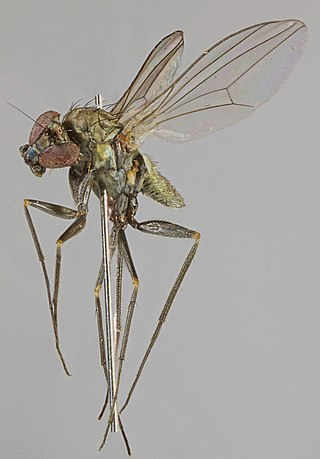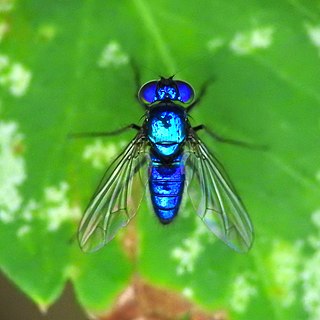
Medetera is a large genus of flies in the family Dolichopodidae. It includes about 350 species worldwide. The adults are commonly found resting on vertical surfaces such as tree trunks, on which they have a characteristic vertical upright stance. Because of this stance, they are sometimes known as "woodpecker flies". Medetera adults are predators of soft-bodied arthropods, while the larvae are predators of bark beetle larvae.
Mesorhaga is a genus of flies in the family Dolichopodidae.
Saccopheronta is a genus of flies in the family Dolichopodidae. It is considered a synonym of Medetera by some authors, and a valid genus by others.

Medeterinae is a subfamily of flies in the family Dolichopodidae.

Medetera truncorum is a species of fly in the family Dolichopodidae. It is widely distributed in the Western Palaearctic. It also occurs in the Pacific Northwest in North America, where it may be an introduced species.
Medetera bistriata is a species of longlegged fly in the family Dolichopodidae. It is widely distributed in North America, spanning from the pine forests of boreal Canada south to Honduras, and it is common in the pine forests of the Atlantic and Gulf costal plains. The larvae are predators of bark beetles in the genera Dendroctonus and Ips, and have been noted as important predators of the southern pine beetle, Dendroctonus frontalis.
Demetera is a genus of flies in the family Dolichopodidae. It contains eight species formerly included in Medetera in the M. melanesiana species group. The species are found in the Afrotropical, Oriental and Australasian regions. According to Naglis and Bickel (2012), it was unwarranted to establish a separate genus for this group of species.

Condylostylus mundus is a species of long-legged fly in the family Dolichopodidae.
Condylostylus graenicheri is a species of long-legged fly in the family Dolichopodidae.
Medetera aberrans is a species of long-legged fly in the family Dolichopodidae. It is distributed in Eastern North America. Adults of the species are generally colored a metallic green, with yellow legs. Not much is known about the biology of the species, but adults have frequently been collected from wet grasslands or marshes.
Medetera apicalis is a species of long-legged fly in the family Dolichopodidae. It is found in Europe and North America. This species is more common in old-growth forest habitats, where it can be found beneath bark or on the fruiting bodies of wood-decaying fungi such as Fomitopsis pinicola.
Chrysotus bellus is a species of long-legged fly in the family Dolichopodidae.

Condylostylus caudatus is a species of long-legged fly in the family Dolichopodidae.
Chrysotus simulans is a species of long-legged fly in the family Dolichopodidae.
Neurigona aestiva is a species of long-legged fly in the family Dolichopodidae.
Dolichopus sincerus is a species of long-legged fly in the family Dolichopodidae.
Tachytrechus sanus is a species of long-legged fly in the family Dolichopodidae.
Chrysotus tarsalis is a species of long-legged fly in the family Dolichopodidae.
Asioligochaetus is a disputed genus of flies in the family Dolichopodidae. It contains only one species, Asioligochaetus vlasovi, which is distributed in Central Asia. Asioligochaetus was originally proposed as a subgenus of Medetera by Oleg Negrobov in 1966. In Bickel (1985)'s revision of the Nearctic Medetera species, Asioligochaetus was treated as a synonym of Medetera, with the only species included as a member of the petulca species group. Alternatively, because of its peculiar combination of characters, Asioligochaetus was raised to genus rank by Igor Grichanov in 2009.




